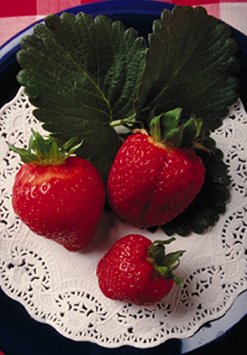As If You Needed Another Reason to Eat Strawberries (with recipe)
Whether draped atop shortcake, cooked with rhubarb and slathered over vanilla ice cream, or downed in the garden just after picking, strawberries are one of summer’s delights. Now, scientists at Cornell University find that this fragile fruit not only tastes great and contains vitamins but also may offer surprisingly potent benefits in the body’s fight against cancer and heart disease.


Rui Hai Liu and his coworkers analyzed eight cultivars for antioxidant properties. Dietary antioxidants can supplement the body’s own, helping protect tissues from runaway damage produced by free radicals.
Ordinarily, the body makes free radicals to break down worn-out cells or to vanquish bacteria and other foreign invaders. When they’ve finished the job, enzymes in the body shut down the production of those free radicals. However, as we age, our bodies tend to become increasingly less adept at this shutdown. Healthy tissues can suffer damage that over time may lead to cancer, heart disease, cataracts, memory loss, or other chronic conditions associated with aging.
Many consumers attempt to combat free-radical threats by downing vitamin pills and other dietary supplements containing antioxidants. Food scientists, however, would prefer that people turn to diet, not pills, for antioxidant supplementation. Plants typically contain additional beneficial micronutrients and a richer array of antioxidant agents than bottled dietary supplements do.
Over the past few years, the Cornell team has been systematically evaluating the antioxidant potency of many fruits. The new studies by Liu’s team were spurred by observations that strawberries can be rich sources of phenolic compounds, such as flavonoids, which have potent antioxidant activity. Indeed, by studying various of those compounds in isolation, scientists have shown that some strawberry phenolics could–at least in the test tube–prevent changes that in animals and people lead to artery-clogging plaque. In the experiments, the phenolics guarded against oxidative changes in low-density lipoprotein (LDL) cholesterol, the so-called bad cholesterol.
In the Journal of Agricultural and Food Chemistry, Liu and his colleagues now show that much of the antioxidant activity in strawberries correlates with gross measures of total phenolics or with the amounts of particularly potent ones, such as the red flavonoid pigments known as anthocyanins.
As with some other berries, strawberry extracts also exhibited potent inhibition of cancer cells’ growth in test tubes. In these experiments, the Earliglow cultivar was twice as potent as Annapolis and about 75 percent more potent than Jewel, Allstar, and Mesabi.
Earliglow also exhibited twice the antioxidant activity of the next-best performing cultivar–Mesabi. However, in the other cultivars, antioxidant potency correlated poorly with measures of how well the extracts thwart cancer-cell proliferation. A similar disconnect between bulk antioxidant activity and protection against cancer-call proliferation appeared in a recent study of raspberries by Liu’s group. The results “may suggest that plant chemicals other than those tested in this experiment are responsible for inhibiting cell proliferation,” Liu says.
Alternatively, the researchers point out, the relative proportions of particular antioxidants may be crucial. Quantities of specific antioxidant compounds varied widely between the tested cultivars, Liu notes. It could be, he speculates, that some compounds may either exaggerate or diminish the potency of accompanying antioxidants–effects that might be masked when assessing cumulative totals of the mix.
RECIPE:
Strawberry Pudding with Blueberry Sauce
This colorful variation of old-fashioned cornstarch pudding is a healthy, strawberry lover’s delight provided by the American Institute of Cancer Research. Yogurt adds creamy lightness without fat. For a glamorous presentation, layer the pudding and sauce in tall, stemmed glasses.
Note: This recipe’s use of blueberries provides additional phenolic antioxidants–ones that offer neuroprotective benefits, at least in animal studies (SN: 9/18/99, p. 180: http://www.sciencenews.org/sn_arc99/9_18_99/fob2.htm).
Pudding:
- 1 pint strawberries
- 1 1/2 cups water
- 1/2 cup sugar
- 1/3 cup cornstarch
- 1 tsp. grated lemon zest
- 1 cup nonfat strawberry yogurt
- 2 tsp. fresh lemon juice
Sauce:
- 1 cup blueberries
- 1/4 cup apple juice concentrate
- 1/4 cup sugar
- 1/2 cup water
Instructions:
- Hull and quarter strawberries, then purée in blender. Pour the resulting puréed fruit into a deep, heavy saucepan.
- Add sugar, lemon zest, and lemon juice to berry purée. Then mix in 1 1/2 cups water.
- In small bowl, mix cornstarch into 1/2 cup cold water until completely dissolved. Stir this starchy liquid into berry mixture.
- Cook berry-cornstarch mixture over medium-high heat, stirring constantly with whisk, until dark patches begin to appear. Reduce heat to medium and continue whisking until mixture thickens; it will turn from pink to soft red before coming to a boil. Pour immediately into medium bowl.
- Cover pudding with piece of plastic wrap to prevent a skin from forming. Cool to room temperature, then refrigerate until ready to serve.
- For syrup, combine blueberries, apple juice concentrate, and sugar with 1/2 cup water in a medium saucepan. Cook over medium-high heat just until berries soften, about 10 minutes, stirring occasionally. Set aside to cool.
- Just before serving, stir yogurt into chilled strawberry mixture until well-combined and pudding has creamy texture. Divide among four bowls. Top with blueberry syrup and serve.
Variations: Add 1 cup fresh or frozen raspberries. Purée, strain to remove seeds, and add to puréed strawberries in pot. Use the same amount of all other ingredients.
Nutritional Information: Makes 4 servings, each with 313 calories and less than 1 gram of fat.







